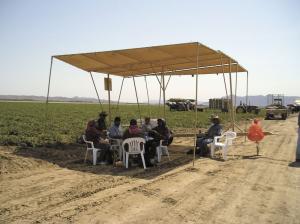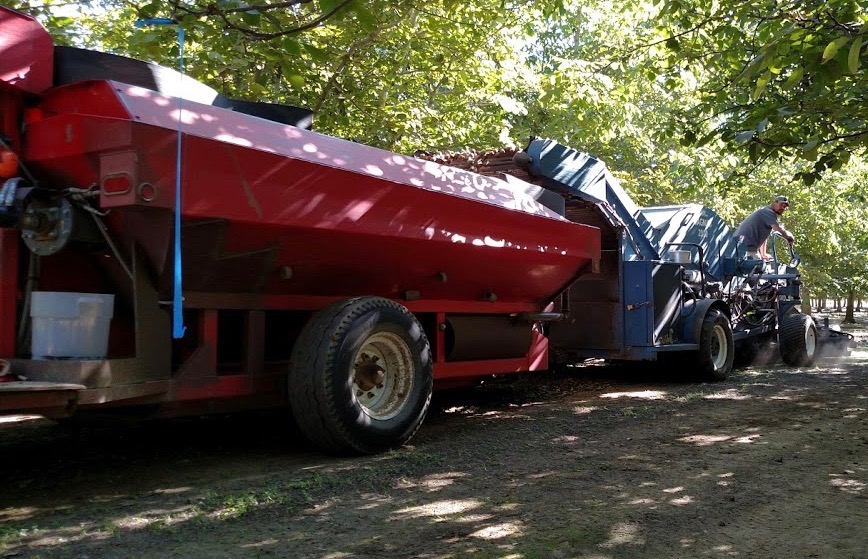Don’t Be Fooled, High Heat Will Return
Farm Employees Must Be Protected During High Temps
By Patrick Cavanaugh, Editor
The cool and rainy weather will eventually turn to higher temperature days, and when high heat returns to the Central Valley, it’s essential that farm employees are getting enough water, rest, and shade. Manuel Cunha, the President of the Nisei Farmers League in Fresno told California Ag Today that during hot days, we’ve got to protect employees.
“Training is the first important step to prevent heat illness,” Cunha said. “All employees and supervisors must know about heat illness prevention.”
Water is the next important step in preventing heat stress.
“Employers or supervisors must provide enough fresh water so that each employee can drink at least one quart per hour—or four 8 ounces glasses per hour—and encourage them to do so,” Cunha said.
Shade is the next critical step to prevent heat illness.
“Employees should have access to shade, and they should be encouraged to take a cool-down rest in the shade for at least 5 minutes,” Cunha explained. “And employees should not wait until they feel sick to cool down.”
Finally, all ag employers must develop and implement written procedures for complying with the Cal/OSHA Heat Illness Prevention Standard.
Temperature Triggers
Shade shall be present when the temperature exceeds 80 degrees Fahrenheit. The employer must maintain one or more areas with shade at all times while employees are present that are either open to the air or provided with ventilation or cooling.
The amount of shade present shall be at least enough to accommodate the number of employees on recovery or rest periods so that they can sit in a healthy posture fully in the shade without having to be in physical contact with each other.
The amount of shade present during meal periods shall be at least enough to accommodate the number of employees on the meal period who remain onsite.
The high-heat hazard temperature is 95 degrees or higher. This is when the employees must take a ten-minute preventative cool-down rest period every two hours. Often, farm operations will cease for the day and restart in the morning.
“Farmers, supervisors, packinghouses, farm labor contractors, all of these folks should have their Heat Action Plan ready, and all employers should be aware of it,” Cunha said. “They have to be ready to go, and that crew bosses, managers, foremen are making sure that the workers are getting shade and drinking plenty of water.”
If farm operations need to change their time schedules to accommodate the high temperatures, they need to implement that, as well as making sure that the workers take their proper breaks, and they have a meal.
“Lunchtime is very important for the workers to be nourished and strong,” Cunha said.
When employees are acclimating to the higher temperatures, a buddy system is essential.
“You want to make sure somebody isn’t sweating a lot or beginning to feel nauseated. As workers, they need to be looking out for each other as well. You cannot always depend on the crew boss seeing a problem,” Cunha explained.
Emergency Contacts
In some places, cell phones don’t work, so workers may have to have a two-way radio. Make sure there is a way to call 911 during an emergency. Make sure you have maps posted to where the employees are working, and all the workers know where they’re at.
“If something goes down, they need to call 911, the worker or crew boss needs to say where they’re at—the address, the location, the cross streets,” Cunha stressed.
“The location should be posted on a clipboard to make sure that you have the information there for those employees,” Cunha continued. “That’s very important, to know the procedures.”
“We want all employees to go home safe to their families every night. So farming operations must have heat illness prevention plans in place,” Cunha said.
Farm operations should be sure that a supervisor is in place in all fieldwork and that supervisor must have first aid and CPR training. And if the supervisor leaves the crew for any reason, they must make sure someone is in charge.
First aid and CPR are vital with our farm crews working in the fields or even in the construction industry. Farm labor contractors must be sure that field supervisors are licensed for first aid and CPR.













